BCO6603 ERP Systems Journey: Stages, Benefits, Barriers, and Examples
VerifiedAdded on 2022/12/29
|12
|4082
|1
Report
AI Summary
This report delves into the concept of an Enterprise Resource Planning (ERP) systems journey, arguing that it is an ongoing process rather than a one-time implementation. It examines the different stages of this journey, from initial assessment to advanced integration, and highlights the potential benefits associated with each stage, such as improved efficiency, cost savings, and enhanced decision-making. The report also identifies the drivers and barriers that influence a company's progression through these stages, including technological advancements, organizational culture, and financial constraints. Using case studies of companies like Cadbury and Hershey's, the report illustrates how different organizations have experienced varying levels of success in their ERP implementations, emphasizing the importance of strategic planning, change management, and continuous improvement. The report concludes by reinforcing the idea that the ERP journey is a dynamic process that requires ongoing evaluation and adaptation to maximize its value.
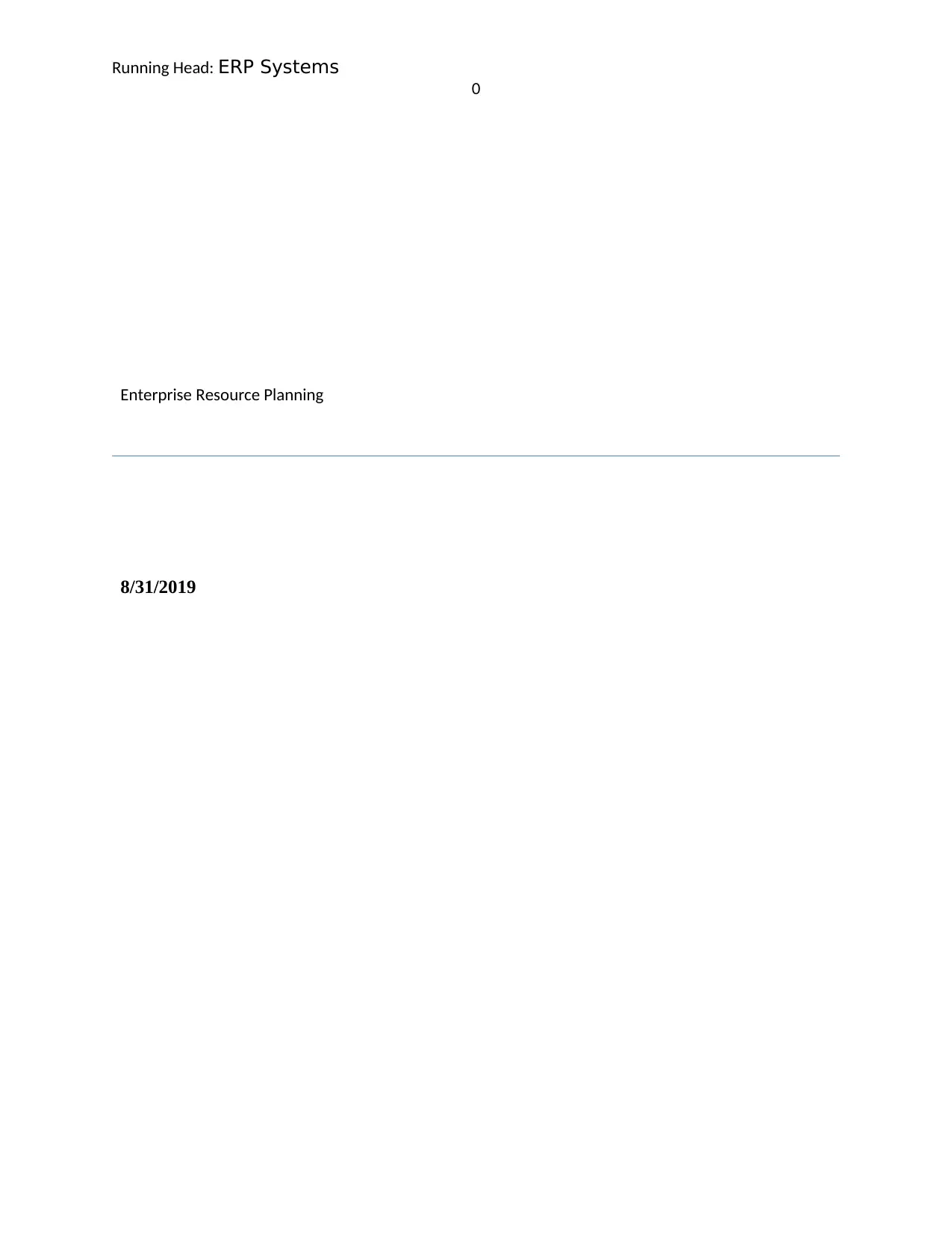
Running Head: ERP Systems
0
Enterprise Resource Planning
8/31/2019
0
Enterprise Resource Planning
8/31/2019
Paraphrase This Document
Need a fresh take? Get an instant paraphrase of this document with our AI Paraphraser
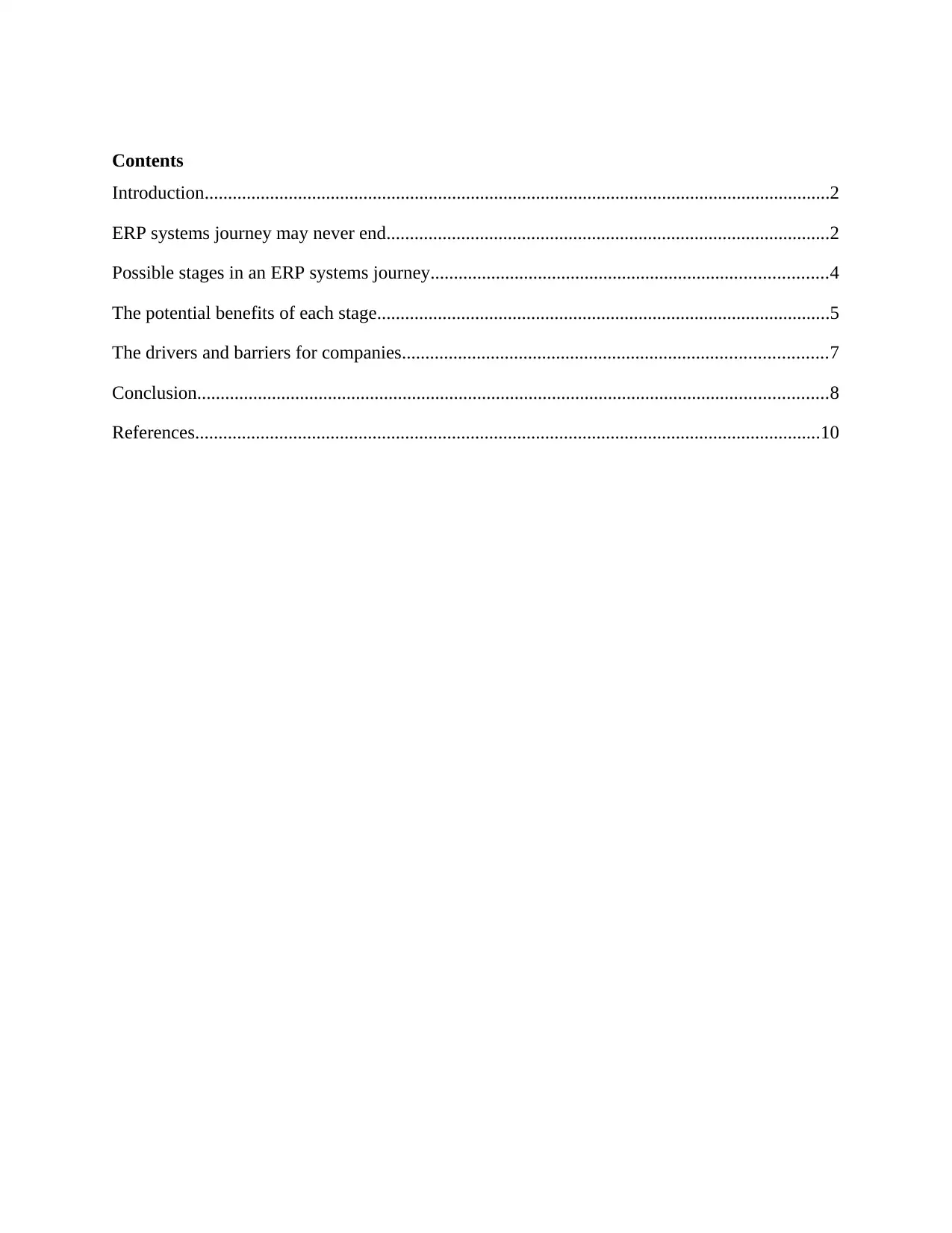
Contents
Introduction......................................................................................................................................2
ERP systems journey may never end...............................................................................................2
Possible stages in an ERP systems journey.....................................................................................4
The potential benefits of each stage.................................................................................................5
The drivers and barriers for companies...........................................................................................7
Conclusion.......................................................................................................................................8
References......................................................................................................................................10
Introduction......................................................................................................................................2
ERP systems journey may never end...............................................................................................2
Possible stages in an ERP systems journey.....................................................................................4
The potential benefits of each stage.................................................................................................5
The drivers and barriers for companies...........................................................................................7
Conclusion.......................................................................................................................................8
References......................................................................................................................................10
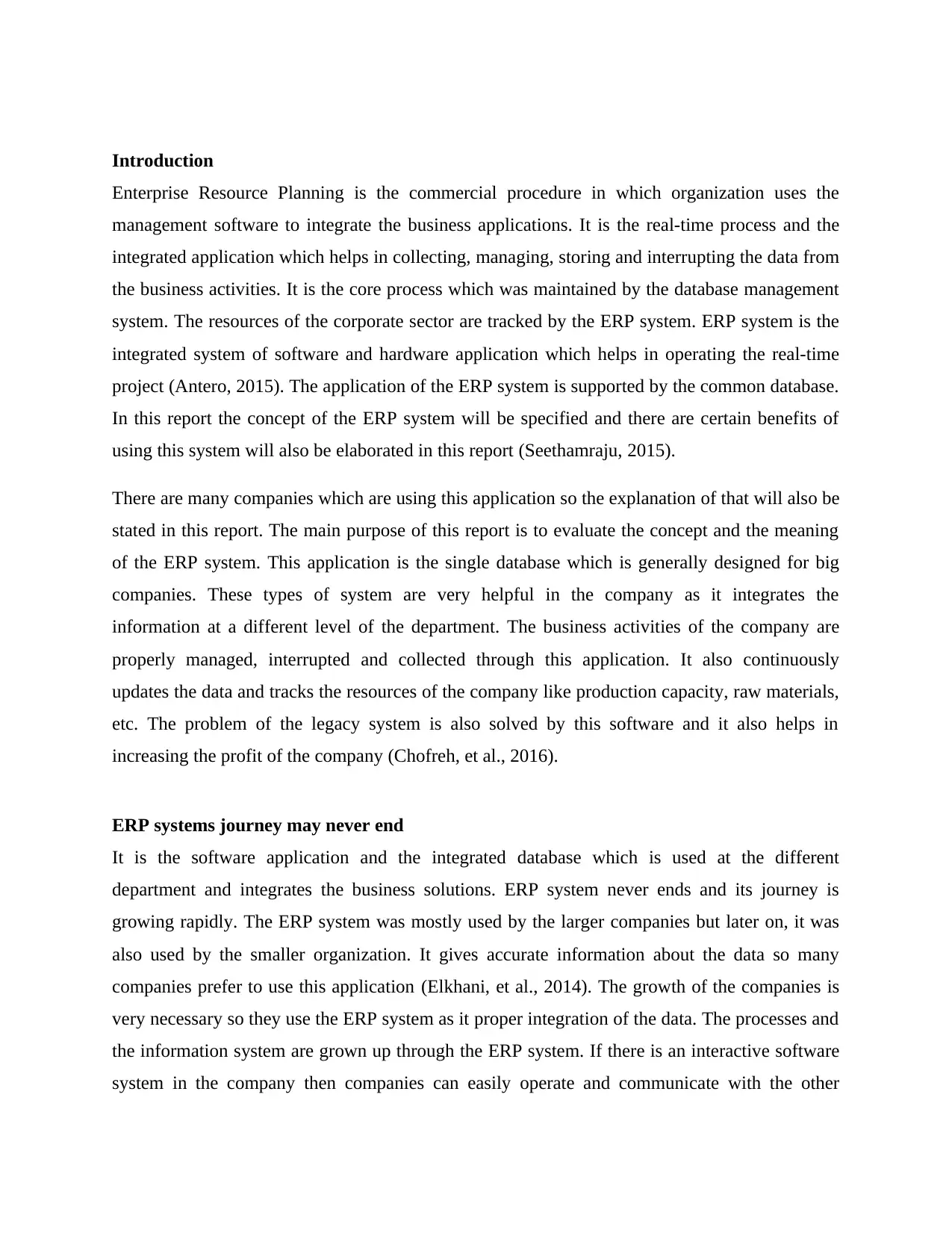
Introduction
Enterprise Resource Planning is the commercial procedure in which organization uses the
management software to integrate the business applications. It is the real-time process and the
integrated application which helps in collecting, managing, storing and interrupting the data from
the business activities. It is the core process which was maintained by the database management
system. The resources of the corporate sector are tracked by the ERP system. ERP system is the
integrated system of software and hardware application which helps in operating the real-time
project (Antero, 2015). The application of the ERP system is supported by the common database.
In this report the concept of the ERP system will be specified and there are certain benefits of
using this system will also be elaborated in this report (Seethamraju, 2015).
There are many companies which are using this application so the explanation of that will also be
stated in this report. The main purpose of this report is to evaluate the concept and the meaning
of the ERP system. This application is the single database which is generally designed for big
companies. These types of system are very helpful in the company as it integrates the
information at a different level of the department. The business activities of the company are
properly managed, interrupted and collected through this application. It also continuously
updates the data and tracks the resources of the company like production capacity, raw materials,
etc. The problem of the legacy system is also solved by this software and it also helps in
increasing the profit of the company (Chofreh, et al., 2016).
ERP systems journey may never end
It is the software application and the integrated database which is used at the different
department and integrates the business solutions. ERP system never ends and its journey is
growing rapidly. The ERP system was mostly used by the larger companies but later on, it was
also used by the smaller organization. It gives accurate information about the data so many
companies prefer to use this application (Elkhani, et al., 2014). The growth of the companies is
very necessary so they use the ERP system as it proper integration of the data. The processes and
the information system are grown up through the ERP system. If there is an interactive software
system in the company then companies can easily operate and communicate with the other
Enterprise Resource Planning is the commercial procedure in which organization uses the
management software to integrate the business applications. It is the real-time process and the
integrated application which helps in collecting, managing, storing and interrupting the data from
the business activities. It is the core process which was maintained by the database management
system. The resources of the corporate sector are tracked by the ERP system. ERP system is the
integrated system of software and hardware application which helps in operating the real-time
project (Antero, 2015). The application of the ERP system is supported by the common database.
In this report the concept of the ERP system will be specified and there are certain benefits of
using this system will also be elaborated in this report (Seethamraju, 2015).
There are many companies which are using this application so the explanation of that will also be
stated in this report. The main purpose of this report is to evaluate the concept and the meaning
of the ERP system. This application is the single database which is generally designed for big
companies. These types of system are very helpful in the company as it integrates the
information at a different level of the department. The business activities of the company are
properly managed, interrupted and collected through this application. It also continuously
updates the data and tracks the resources of the company like production capacity, raw materials,
etc. The problem of the legacy system is also solved by this software and it also helps in
increasing the profit of the company (Chofreh, et al., 2016).
ERP systems journey may never end
It is the software application and the integrated database which is used at the different
department and integrates the business solutions. ERP system never ends and its journey is
growing rapidly. The ERP system was mostly used by the larger companies but later on, it was
also used by the smaller organization. It gives accurate information about the data so many
companies prefer to use this application (Elkhani, et al., 2014). The growth of the companies is
very necessary so they use the ERP system as it proper integration of the data. The processes and
the information system are grown up through the ERP system. If there is an interactive software
system in the company then companies can easily operate and communicate with the other
⊘ This is a preview!⊘
Do you want full access?
Subscribe today to unlock all pages.

Trusted by 1+ million students worldwide
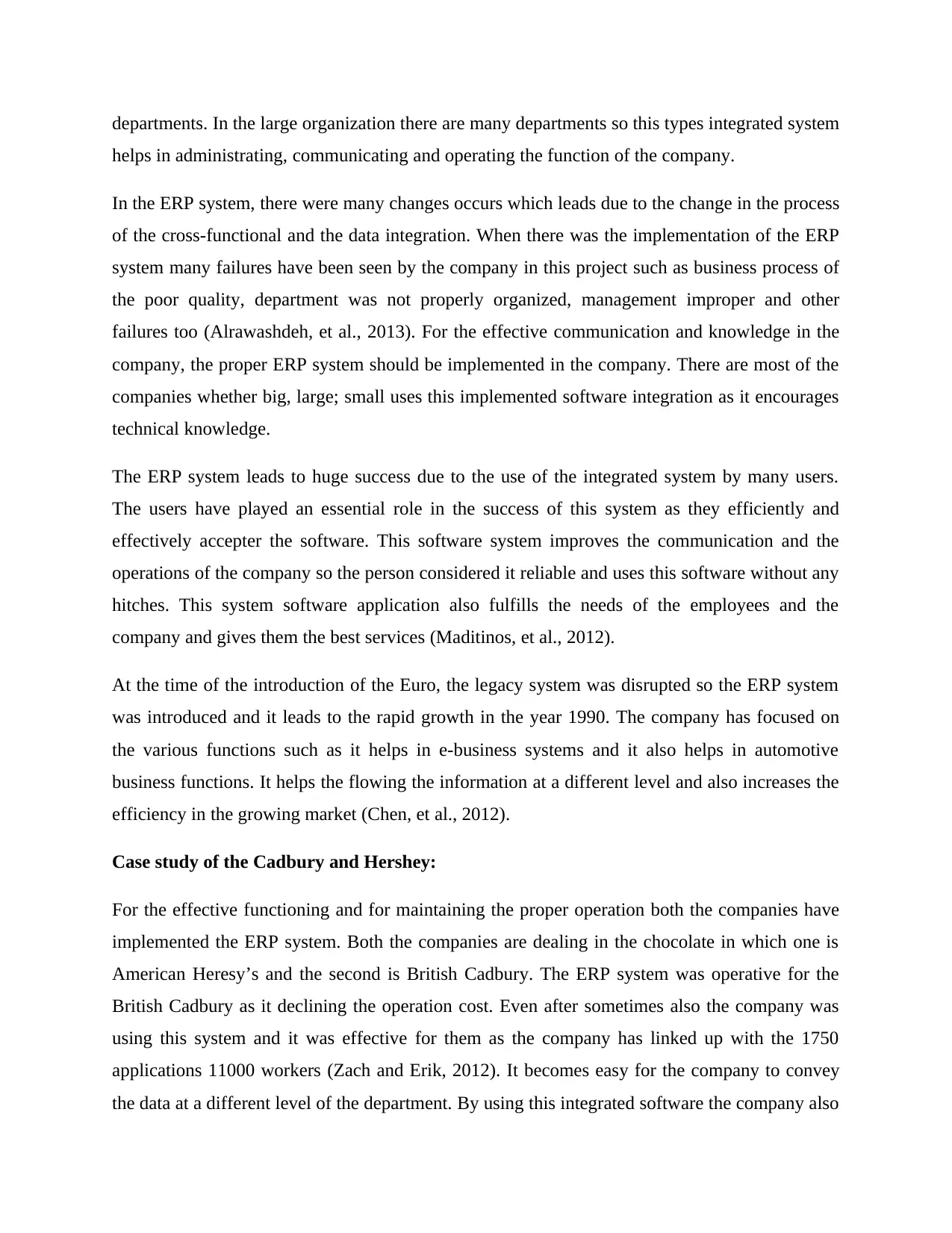
departments. In the large organization there are many departments so this types integrated system
helps in administrating, communicating and operating the function of the company.
In the ERP system, there were many changes occurs which leads due to the change in the process
of the cross-functional and the data integration. When there was the implementation of the ERP
system many failures have been seen by the company in this project such as business process of
the poor quality, department was not properly organized, management improper and other
failures too (Alrawashdeh, et al., 2013). For the effective communication and knowledge in the
company, the proper ERP system should be implemented in the company. There are most of the
companies whether big, large; small uses this implemented software integration as it encourages
technical knowledge.
The ERP system leads to huge success due to the use of the integrated system by many users.
The users have played an essential role in the success of this system as they efficiently and
effectively accepter the software. This software system improves the communication and the
operations of the company so the person considered it reliable and uses this software without any
hitches. This system software application also fulfills the needs of the employees and the
company and gives them the best services (Maditinos, et al., 2012).
At the time of the introduction of the Euro, the legacy system was disrupted so the ERP system
was introduced and it leads to the rapid growth in the year 1990. The company has focused on
the various functions such as it helps in e-business systems and it also helps in automotive
business functions. It helps the flowing the information at a different level and also increases the
efficiency in the growing market (Chen, et al., 2012).
Case study of the Cadbury and Hershey:
For the effective functioning and for maintaining the proper operation both the companies have
implemented the ERP system. Both the companies are dealing in the chocolate in which one is
American Heresy’s and the second is British Cadbury. The ERP system was operative for the
British Cadbury as it declining the operation cost. Even after sometimes also the company was
using this system and it was effective for them as the company has linked up with the 1750
applications 11000 workers (Zach and Erik, 2012). It becomes easy for the company to convey
the data at a different level of the department. By using this integrated software the company also
helps in administrating, communicating and operating the function of the company.
In the ERP system, there were many changes occurs which leads due to the change in the process
of the cross-functional and the data integration. When there was the implementation of the ERP
system many failures have been seen by the company in this project such as business process of
the poor quality, department was not properly organized, management improper and other
failures too (Alrawashdeh, et al., 2013). For the effective communication and knowledge in the
company, the proper ERP system should be implemented in the company. There are most of the
companies whether big, large; small uses this implemented software integration as it encourages
technical knowledge.
The ERP system leads to huge success due to the use of the integrated system by many users.
The users have played an essential role in the success of this system as they efficiently and
effectively accepter the software. This software system improves the communication and the
operations of the company so the person considered it reliable and uses this software without any
hitches. This system software application also fulfills the needs of the employees and the
company and gives them the best services (Maditinos, et al., 2012).
At the time of the introduction of the Euro, the legacy system was disrupted so the ERP system
was introduced and it leads to the rapid growth in the year 1990. The company has focused on
the various functions such as it helps in e-business systems and it also helps in automotive
business functions. It helps the flowing the information at a different level and also increases the
efficiency in the growing market (Chen, et al., 2012).
Case study of the Cadbury and Hershey:
For the effective functioning and for maintaining the proper operation both the companies have
implemented the ERP system. Both the companies are dealing in the chocolate in which one is
American Heresy’s and the second is British Cadbury. The ERP system was operative for the
British Cadbury as it declining the operation cost. Even after sometimes also the company was
using this system and it was effective for them as the company has linked up with the 1750
applications 11000 workers (Zach and Erik, 2012). It becomes easy for the company to convey
the data at a different level of the department. By using this integrated software the company also
Paraphrase This Document
Need a fresh take? Get an instant paraphrase of this document with our AI Paraphraser
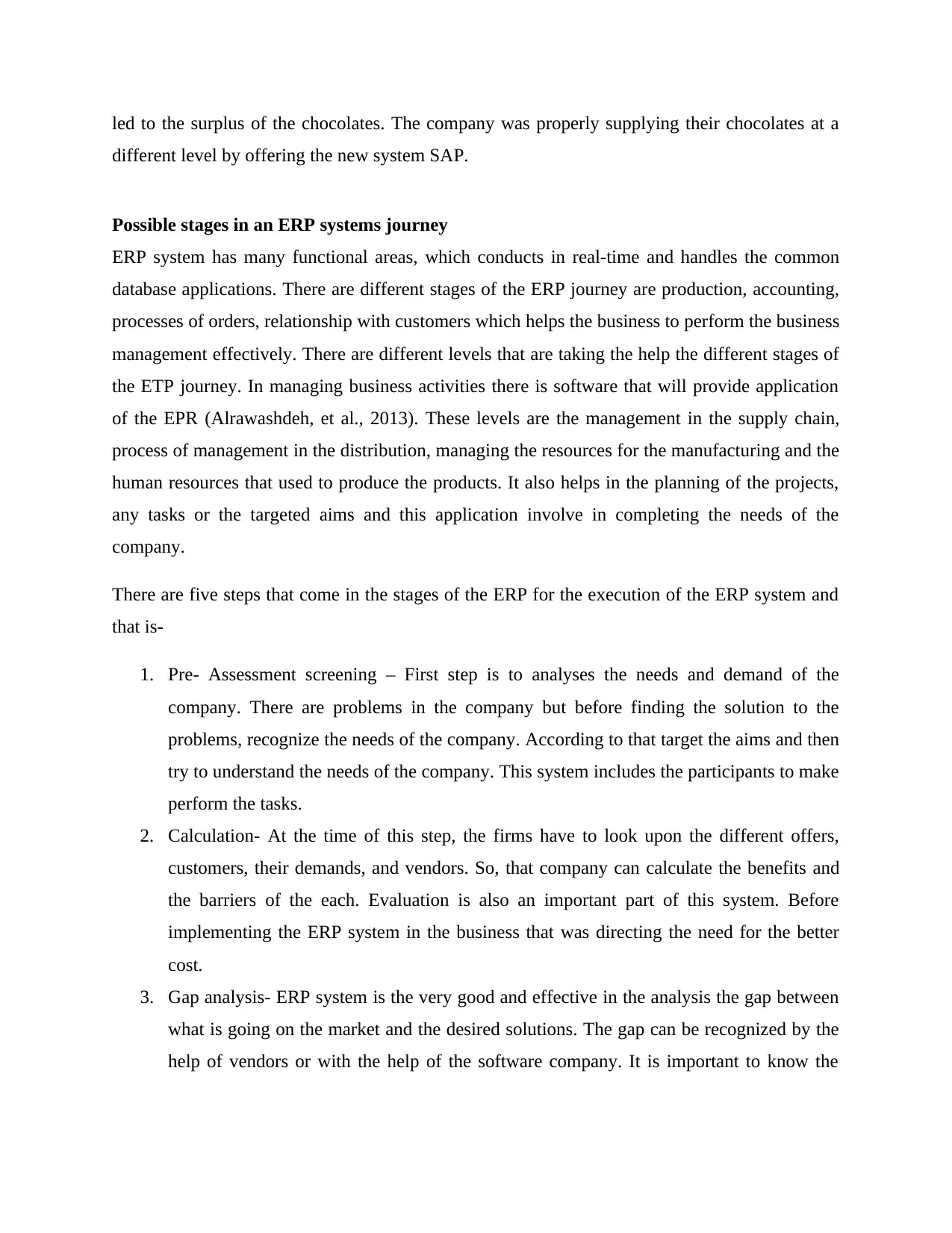
led to the surplus of the chocolates. The company was properly supplying their chocolates at a
different level by offering the new system SAP.
Possible stages in an ERP systems journey
ERP system has many functional areas, which conducts in real-time and handles the common
database applications. There are different stages of the ERP journey are production, accounting,
processes of orders, relationship with customers which helps the business to perform the business
management effectively. There are different levels that are taking the help the different stages of
the ETP journey. In managing business activities there is software that will provide application
of the EPR (Alrawashdeh, et al., 2013). These levels are the management in the supply chain,
process of management in the distribution, managing the resources for the manufacturing and the
human resources that used to produce the products. It also helps in the planning of the projects,
any tasks or the targeted aims and this application involve in completing the needs of the
company.
There are five steps that come in the stages of the ERP for the execution of the ERP system and
that is-
1. Pre- Assessment screening – First step is to analyses the needs and demand of the
company. There are problems in the company but before finding the solution to the
problems, recognize the needs of the company. According to that target the aims and then
try to understand the needs of the company. This system includes the participants to make
perform the tasks.
2. Calculation- At the time of this step, the firms have to look upon the different offers,
customers, their demands, and vendors. So, that company can calculate the benefits and
the barriers of the each. Evaluation is also an important part of this system. Before
implementing the ERP system in the business that was directing the need for the better
cost.
3. Gap analysis- ERP system is the very good and effective in the analysis the gap between
what is going on the market and the desired solutions. The gap can be recognized by the
help of vendors or with the help of the software company. It is important to know the
different level by offering the new system SAP.
Possible stages in an ERP systems journey
ERP system has many functional areas, which conducts in real-time and handles the common
database applications. There are different stages of the ERP journey are production, accounting,
processes of orders, relationship with customers which helps the business to perform the business
management effectively. There are different levels that are taking the help the different stages of
the ETP journey. In managing business activities there is software that will provide application
of the EPR (Alrawashdeh, et al., 2013). These levels are the management in the supply chain,
process of management in the distribution, managing the resources for the manufacturing and the
human resources that used to produce the products. It also helps in the planning of the projects,
any tasks or the targeted aims and this application involve in completing the needs of the
company.
There are five steps that come in the stages of the ERP for the execution of the ERP system and
that is-
1. Pre- Assessment screening – First step is to analyses the needs and demand of the
company. There are problems in the company but before finding the solution to the
problems, recognize the needs of the company. According to that target the aims and then
try to understand the needs of the company. This system includes the participants to make
perform the tasks.
2. Calculation- At the time of this step, the firms have to look upon the different offers,
customers, their demands, and vendors. So, that company can calculate the benefits and
the barriers of the each. Evaluation is also an important part of this system. Before
implementing the ERP system in the business that was directing the need for the better
cost.
3. Gap analysis- ERP system is the very good and effective in the analysis the gap between
what is going on the market and the desired solutions. The gap can be recognized by the
help of vendors or with the help of the software company. It is important to know the
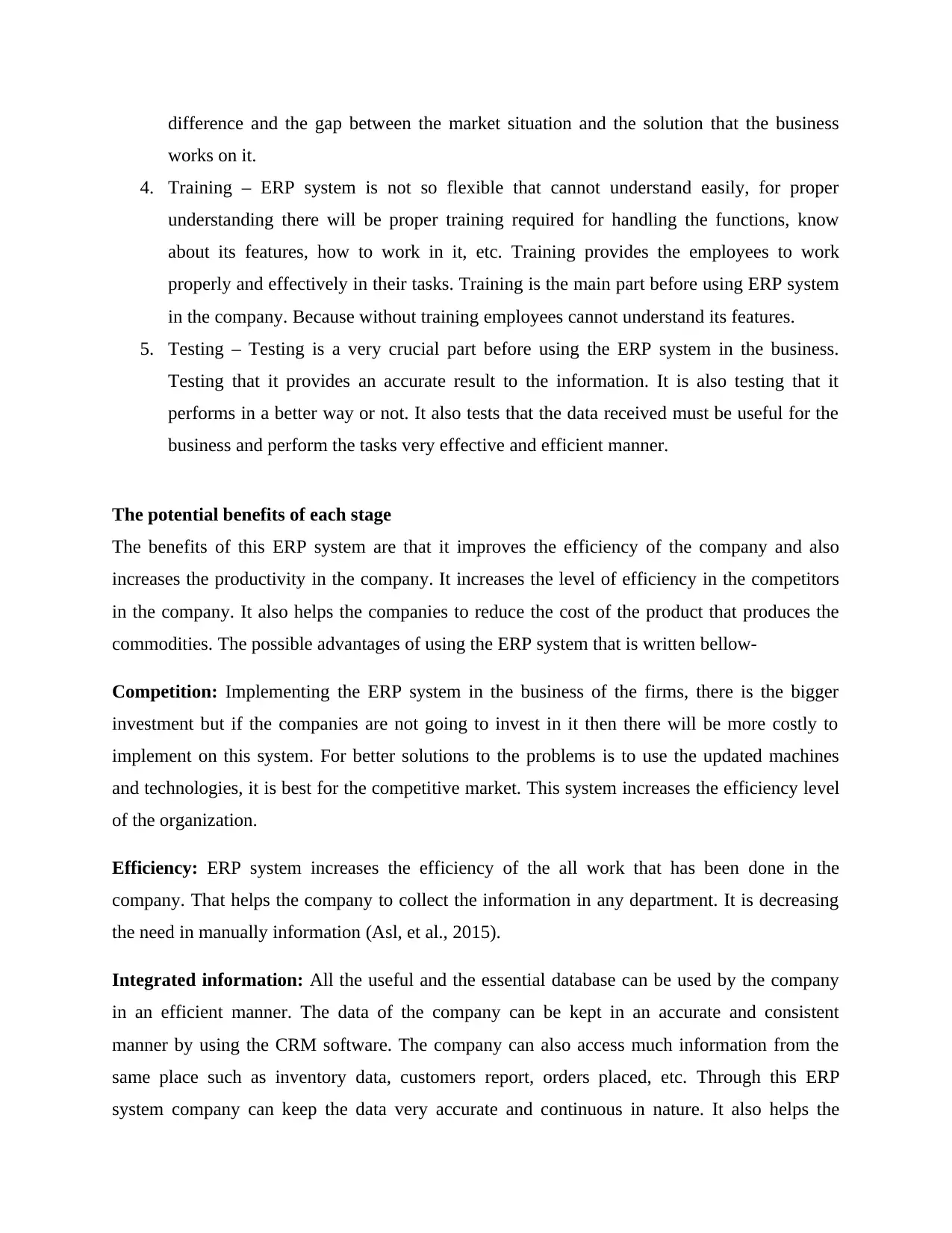
difference and the gap between the market situation and the solution that the business
works on it.
4. Training – ERP system is not so flexible that cannot understand easily, for proper
understanding there will be proper training required for handling the functions, know
about its features, how to work in it, etc. Training provides the employees to work
properly and effectively in their tasks. Training is the main part before using ERP system
in the company. Because without training employees cannot understand its features.
5. Testing – Testing is a very crucial part before using the ERP system in the business.
Testing that it provides an accurate result to the information. It is also testing that it
performs in a better way or not. It also tests that the data received must be useful for the
business and perform the tasks very effective and efficient manner.
The potential benefits of each stage
The benefits of this ERP system are that it improves the efficiency of the company and also
increases the productivity in the company. It increases the level of efficiency in the competitors
in the company. It also helps the companies to reduce the cost of the product that produces the
commodities. The possible advantages of using the ERP system that is written bellow-
Competition: Implementing the ERP system in the business of the firms, there is the bigger
investment but if the companies are not going to invest in it then there will be more costly to
implement on this system. For better solutions to the problems is to use the updated machines
and technologies, it is best for the competitive market. This system increases the efficiency level
of the organization.
Efficiency: ERP system increases the efficiency of the all work that has been done in the
company. That helps the company to collect the information in any department. It is decreasing
the need in manually information (Asl, et al., 2015).
Integrated information: All the useful and the essential database can be used by the company
in an efficient manner. The data of the company can be kept in an accurate and consistent
manner by using the CRM software. The company can also access much information from the
same place such as inventory data, customers report, orders placed, etc. Through this ERP
system company can keep the data very accurate and continuous in nature. It also helps the
works on it.
4. Training – ERP system is not so flexible that cannot understand easily, for proper
understanding there will be proper training required for handling the functions, know
about its features, how to work in it, etc. Training provides the employees to work
properly and effectively in their tasks. Training is the main part before using ERP system
in the company. Because without training employees cannot understand its features.
5. Testing – Testing is a very crucial part before using the ERP system in the business.
Testing that it provides an accurate result to the information. It is also testing that it
performs in a better way or not. It also tests that the data received must be useful for the
business and perform the tasks very effective and efficient manner.
The potential benefits of each stage
The benefits of this ERP system are that it improves the efficiency of the company and also
increases the productivity in the company. It increases the level of efficiency in the competitors
in the company. It also helps the companies to reduce the cost of the product that produces the
commodities. The possible advantages of using the ERP system that is written bellow-
Competition: Implementing the ERP system in the business of the firms, there is the bigger
investment but if the companies are not going to invest in it then there will be more costly to
implement on this system. For better solutions to the problems is to use the updated machines
and technologies, it is best for the competitive market. This system increases the efficiency level
of the organization.
Efficiency: ERP system increases the efficiency of the all work that has been done in the
company. That helps the company to collect the information in any department. It is decreasing
the need in manually information (Asl, et al., 2015).
Integrated information: All the useful and the essential database can be used by the company
in an efficient manner. The data of the company can be kept in an accurate and consistent
manner by using the CRM software. The company can also access much information from the
same place such as inventory data, customers report, orders placed, etc. Through this ERP
system company can keep the data very accurate and continuous in nature. It also helps the
⊘ This is a preview!⊘
Do you want full access?
Subscribe today to unlock all pages.

Trusted by 1+ million students worldwide
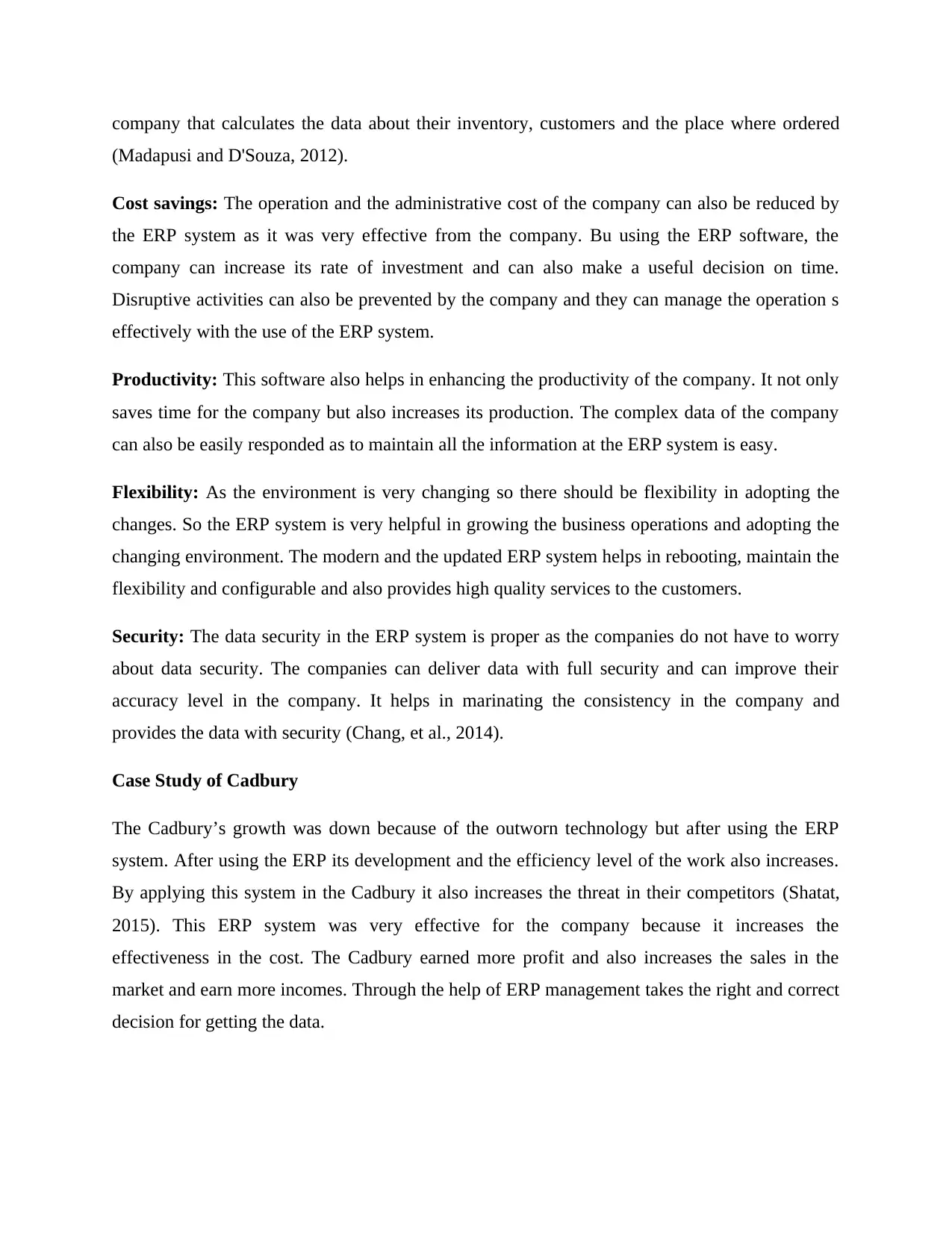
company that calculates the data about their inventory, customers and the place where ordered
(Madapusi and D'Souza, 2012).
Cost savings: The operation and the administrative cost of the company can also be reduced by
the ERP system as it was very effective from the company. Bu using the ERP software, the
company can increase its rate of investment and can also make a useful decision on time.
Disruptive activities can also be prevented by the company and they can manage the operation s
effectively with the use of the ERP system.
Productivity: This software also helps in enhancing the productivity of the company. It not only
saves time for the company but also increases its production. The complex data of the company
can also be easily responded as to maintain all the information at the ERP system is easy.
Flexibility: As the environment is very changing so there should be flexibility in adopting the
changes. So the ERP system is very helpful in growing the business operations and adopting the
changing environment. The modern and the updated ERP system helps in rebooting, maintain the
flexibility and configurable and also provides high quality services to the customers.
Security: The data security in the ERP system is proper as the companies do not have to worry
about data security. The companies can deliver data with full security and can improve their
accuracy level in the company. It helps in marinating the consistency in the company and
provides the data with security (Chang, et al., 2014).
Case Study of Cadbury
The Cadbury’s growth was down because of the outworn technology but after using the ERP
system. After using the ERP its development and the efficiency level of the work also increases.
By applying this system in the Cadbury it also increases the threat in their competitors (Shatat,
2015). This ERP system was very effective for the company because it increases the
effectiveness in the cost. The Cadbury earned more profit and also increases the sales in the
market and earn more incomes. Through the help of ERP management takes the right and correct
decision for getting the data.
(Madapusi and D'Souza, 2012).
Cost savings: The operation and the administrative cost of the company can also be reduced by
the ERP system as it was very effective from the company. Bu using the ERP software, the
company can increase its rate of investment and can also make a useful decision on time.
Disruptive activities can also be prevented by the company and they can manage the operation s
effectively with the use of the ERP system.
Productivity: This software also helps in enhancing the productivity of the company. It not only
saves time for the company but also increases its production. The complex data of the company
can also be easily responded as to maintain all the information at the ERP system is easy.
Flexibility: As the environment is very changing so there should be flexibility in adopting the
changes. So the ERP system is very helpful in growing the business operations and adopting the
changing environment. The modern and the updated ERP system helps in rebooting, maintain the
flexibility and configurable and also provides high quality services to the customers.
Security: The data security in the ERP system is proper as the companies do not have to worry
about data security. The companies can deliver data with full security and can improve their
accuracy level in the company. It helps in marinating the consistency in the company and
provides the data with security (Chang, et al., 2014).
Case Study of Cadbury
The Cadbury’s growth was down because of the outworn technology but after using the ERP
system. After using the ERP its development and the efficiency level of the work also increases.
By applying this system in the Cadbury it also increases the threat in their competitors (Shatat,
2015). This ERP system was very effective for the company because it increases the
effectiveness in the cost. The Cadbury earned more profit and also increases the sales in the
market and earn more incomes. Through the help of ERP management takes the right and correct
decision for getting the data.
Paraphrase This Document
Need a fresh take? Get an instant paraphrase of this document with our AI Paraphraser
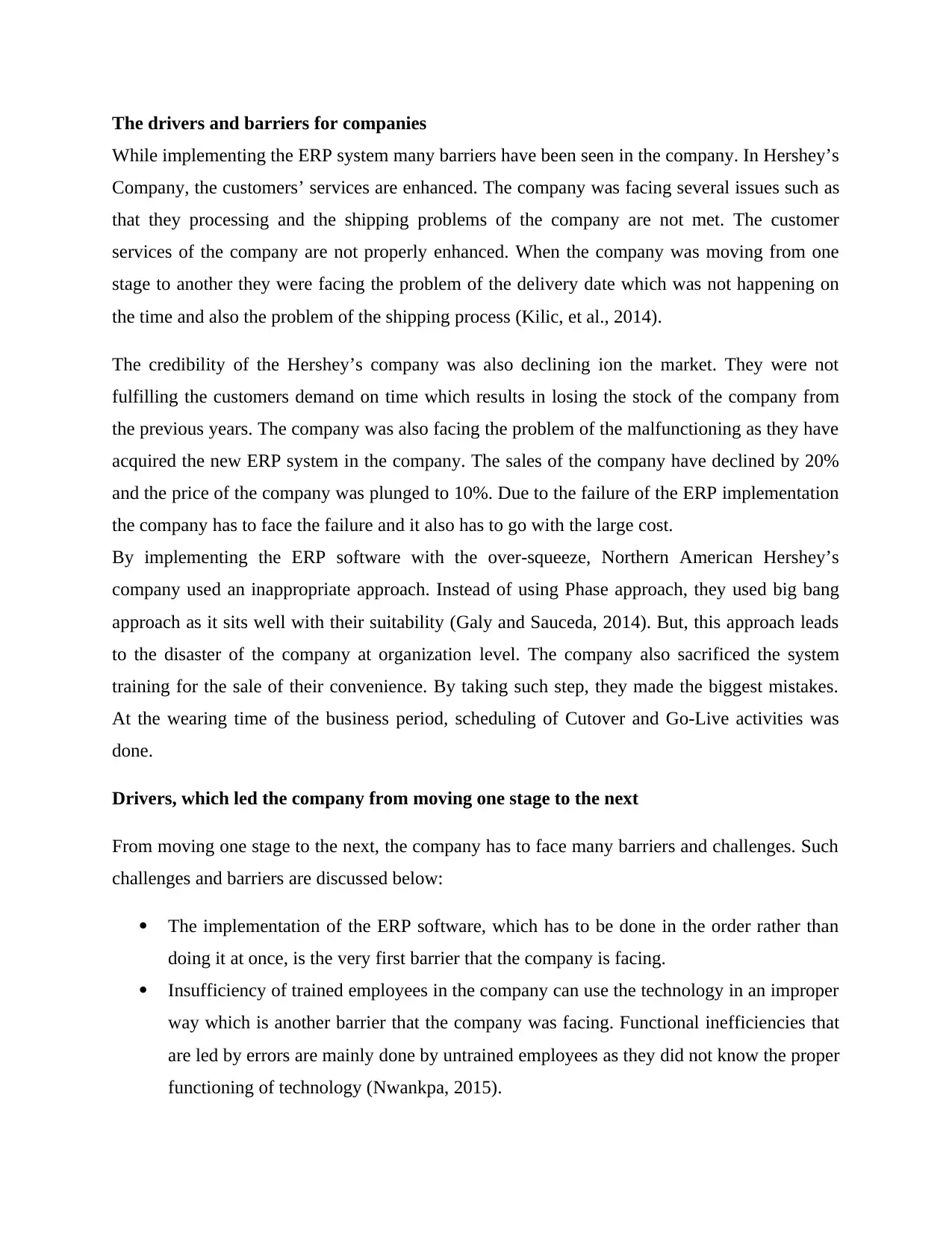
The drivers and barriers for companies
While implementing the ERP system many barriers have been seen in the company. In Hershey’s
Company, the customers’ services are enhanced. The company was facing several issues such as
that they processing and the shipping problems of the company are not met. The customer
services of the company are not properly enhanced. When the company was moving from one
stage to another they were facing the problem of the delivery date which was not happening on
the time and also the problem of the shipping process (Kilic, et al., 2014).
The credibility of the Hershey’s company was also declining ion the market. They were not
fulfilling the customers demand on time which results in losing the stock of the company from
the previous years. The company was also facing the problem of the malfunctioning as they have
acquired the new ERP system in the company. The sales of the company have declined by 20%
and the price of the company was plunged to 10%. Due to the failure of the ERP implementation
the company has to face the failure and it also has to go with the large cost.
By implementing the ERP software with the over-squeeze, Northern American Hershey’s
company used an inappropriate approach. Instead of using Phase approach, they used big bang
approach as it sits well with their suitability (Galy and Sauceda, 2014). But, this approach leads
to the disaster of the company at organization level. The company also sacrificed the system
training for the sale of their convenience. By taking such step, they made the biggest mistakes.
At the wearing time of the business period, scheduling of Cutover and Go-Live activities was
done.
Drivers, which led the company from moving one stage to the next
From moving one stage to the next, the company has to face many barriers and challenges. Such
challenges and barriers are discussed below:
The implementation of the ERP software, which has to be done in the order rather than
doing it at once, is the very first barrier that the company is facing.
Insufficiency of trained employees in the company can use the technology in an improper
way which is another barrier that the company was facing. Functional inefficiencies that
are led by errors are mainly done by untrained employees as they did not know the proper
functioning of technology (Nwankpa, 2015).
While implementing the ERP system many barriers have been seen in the company. In Hershey’s
Company, the customers’ services are enhanced. The company was facing several issues such as
that they processing and the shipping problems of the company are not met. The customer
services of the company are not properly enhanced. When the company was moving from one
stage to another they were facing the problem of the delivery date which was not happening on
the time and also the problem of the shipping process (Kilic, et al., 2014).
The credibility of the Hershey’s company was also declining ion the market. They were not
fulfilling the customers demand on time which results in losing the stock of the company from
the previous years. The company was also facing the problem of the malfunctioning as they have
acquired the new ERP system in the company. The sales of the company have declined by 20%
and the price of the company was plunged to 10%. Due to the failure of the ERP implementation
the company has to face the failure and it also has to go with the large cost.
By implementing the ERP software with the over-squeeze, Northern American Hershey’s
company used an inappropriate approach. Instead of using Phase approach, they used big bang
approach as it sits well with their suitability (Galy and Sauceda, 2014). But, this approach leads
to the disaster of the company at organization level. The company also sacrificed the system
training for the sale of their convenience. By taking such step, they made the biggest mistakes.
At the wearing time of the business period, scheduling of Cutover and Go-Live activities was
done.
Drivers, which led the company from moving one stage to the next
From moving one stage to the next, the company has to face many barriers and challenges. Such
challenges and barriers are discussed below:
The implementation of the ERP software, which has to be done in the order rather than
doing it at once, is the very first barrier that the company is facing.
Insufficiency of trained employees in the company can use the technology in an improper
way which is another barrier that the company was facing. Functional inefficiencies that
are led by errors are mainly done by untrained employees as they did not know the proper
functioning of technology (Nwankpa, 2015).
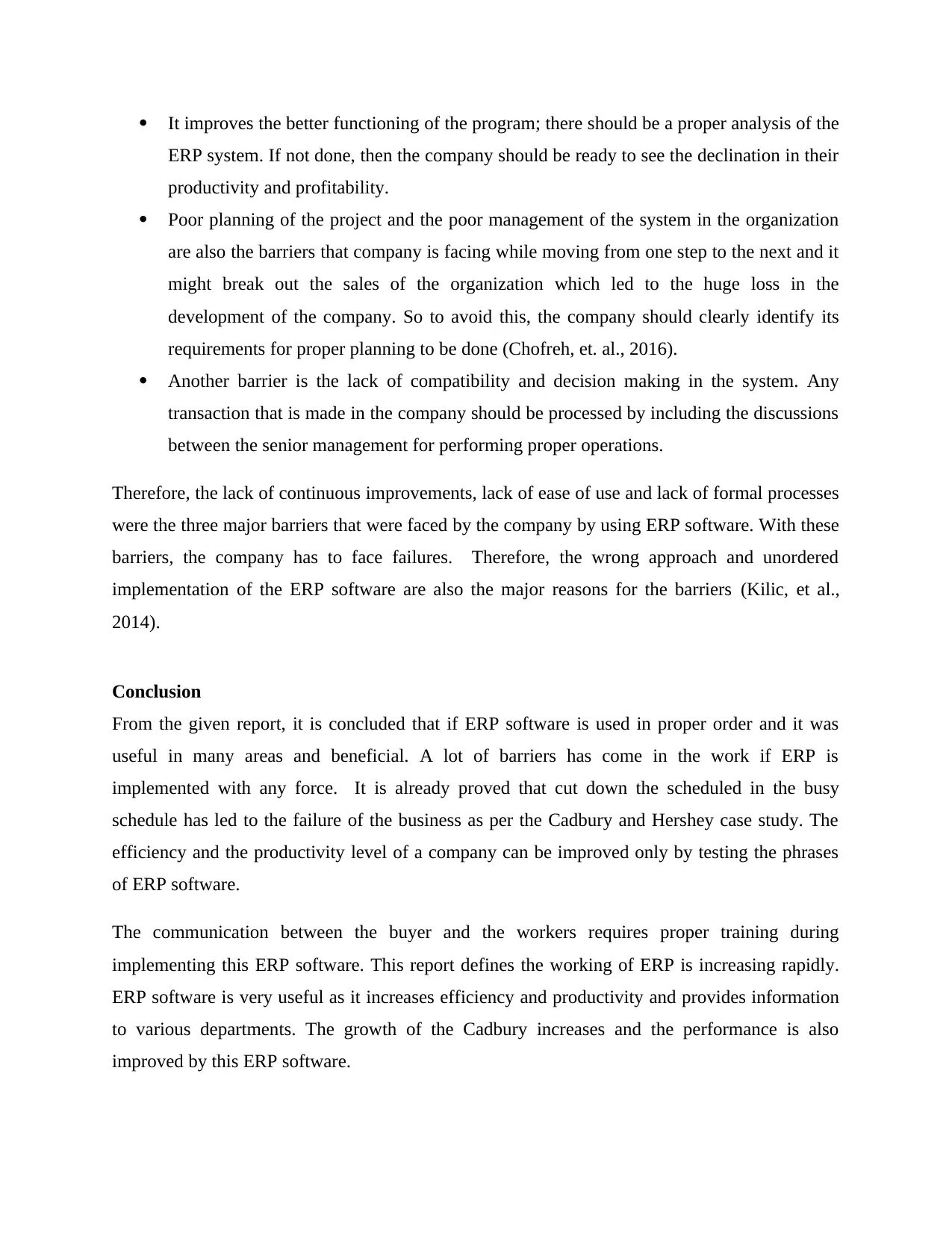
It improves the better functioning of the program; there should be a proper analysis of the
ERP system. If not done, then the company should be ready to see the declination in their
productivity and profitability.
Poor planning of the project and the poor management of the system in the organization
are also the barriers that company is facing while moving from one step to the next and it
might break out the sales of the organization which led to the huge loss in the
development of the company. So to avoid this, the company should clearly identify its
requirements for proper planning to be done (Chofreh, et. al., 2016).
Another barrier is the lack of compatibility and decision making in the system. Any
transaction that is made in the company should be processed by including the discussions
between the senior management for performing proper operations.
Therefore, the lack of continuous improvements, lack of ease of use and lack of formal processes
were the three major barriers that were faced by the company by using ERP software. With these
barriers, the company has to face failures. Therefore, the wrong approach and unordered
implementation of the ERP software are also the major reasons for the barriers (Kilic, et al.,
2014).
Conclusion
From the given report, it is concluded that if ERP software is used in proper order and it was
useful in many areas and beneficial. A lot of barriers has come in the work if ERP is
implemented with any force. It is already proved that cut down the scheduled in the busy
schedule has led to the failure of the business as per the Cadbury and Hershey case study. The
efficiency and the productivity level of a company can be improved only by testing the phrases
of ERP software.
The communication between the buyer and the workers requires proper training during
implementing this ERP software. This report defines the working of ERP is increasing rapidly.
ERP software is very useful as it increases efficiency and productivity and provides information
to various departments. The growth of the Cadbury increases and the performance is also
improved by this ERP software.
ERP system. If not done, then the company should be ready to see the declination in their
productivity and profitability.
Poor planning of the project and the poor management of the system in the organization
are also the barriers that company is facing while moving from one step to the next and it
might break out the sales of the organization which led to the huge loss in the
development of the company. So to avoid this, the company should clearly identify its
requirements for proper planning to be done (Chofreh, et. al., 2016).
Another barrier is the lack of compatibility and decision making in the system. Any
transaction that is made in the company should be processed by including the discussions
between the senior management for performing proper operations.
Therefore, the lack of continuous improvements, lack of ease of use and lack of formal processes
were the three major barriers that were faced by the company by using ERP software. With these
barriers, the company has to face failures. Therefore, the wrong approach and unordered
implementation of the ERP software are also the major reasons for the barriers (Kilic, et al.,
2014).
Conclusion
From the given report, it is concluded that if ERP software is used in proper order and it was
useful in many areas and beneficial. A lot of barriers has come in the work if ERP is
implemented with any force. It is already proved that cut down the scheduled in the busy
schedule has led to the failure of the business as per the Cadbury and Hershey case study. The
efficiency and the productivity level of a company can be improved only by testing the phrases
of ERP software.
The communication between the buyer and the workers requires proper training during
implementing this ERP software. This report defines the working of ERP is increasing rapidly.
ERP software is very useful as it increases efficiency and productivity and provides information
to various departments. The growth of the Cadbury increases and the performance is also
improved by this ERP software.
⊘ This is a preview!⊘
Do you want full access?
Subscribe today to unlock all pages.

Trusted by 1+ million students worldwide
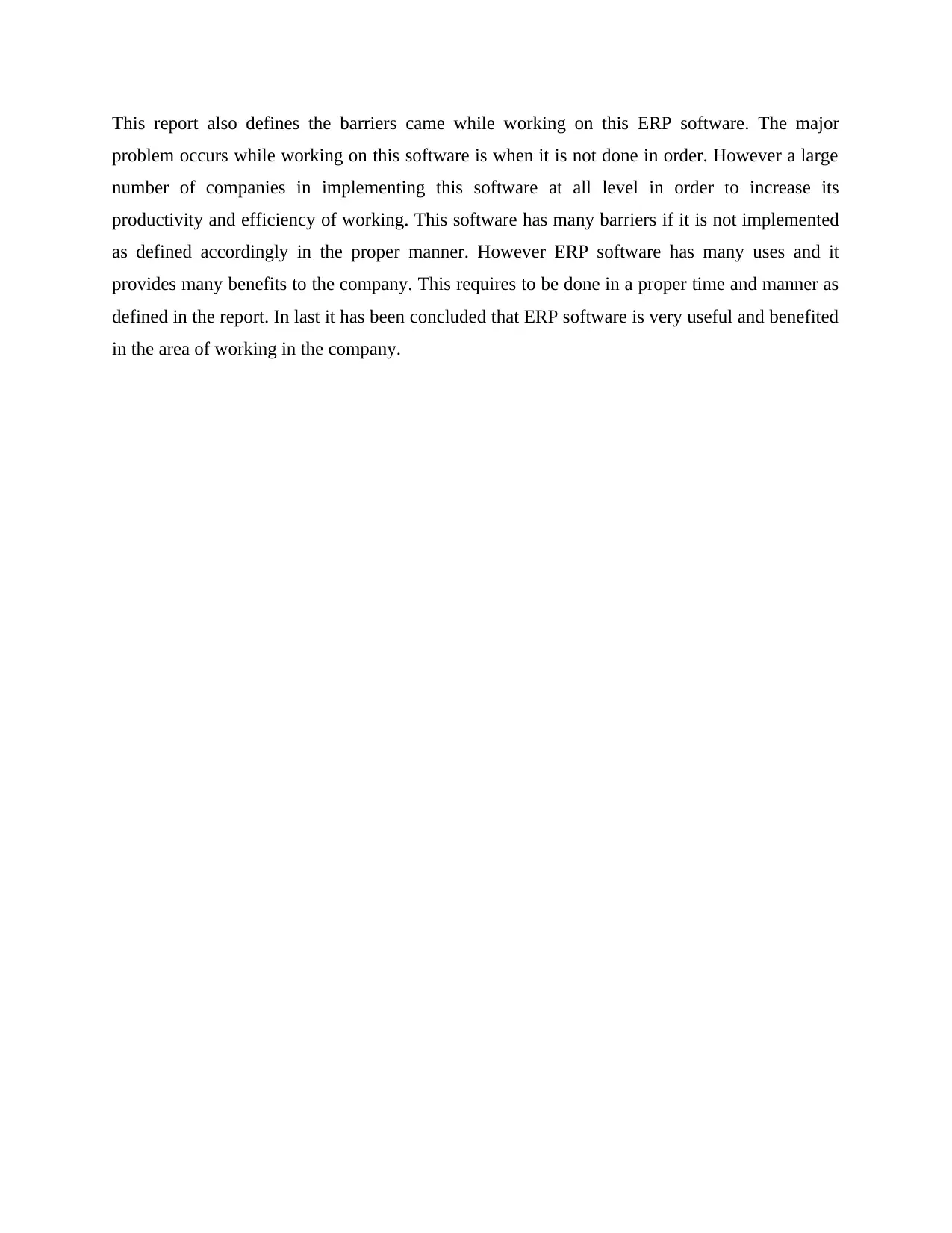
This report also defines the barriers came while working on this ERP software. The major
problem occurs while working on this software is when it is not done in order. However a large
number of companies in implementing this software at all level in order to increase its
productivity and efficiency of working. This software has many barriers if it is not implemented
as defined accordingly in the proper manner. However ERP software has many uses and it
provides many benefits to the company. This requires to be done in a proper time and manner as
defined in the report. In last it has been concluded that ERP software is very useful and benefited
in the area of working in the company.
problem occurs while working on this software is when it is not done in order. However a large
number of companies in implementing this software at all level in order to increase its
productivity and efficiency of working. This software has many barriers if it is not implemented
as defined accordingly in the proper manner. However ERP software has many uses and it
provides many benefits to the company. This requires to be done in a proper time and manner as
defined in the report. In last it has been concluded that ERP software is very useful and benefited
in the area of working in the company.
Paraphrase This Document
Need a fresh take? Get an instant paraphrase of this document with our AI Paraphraser
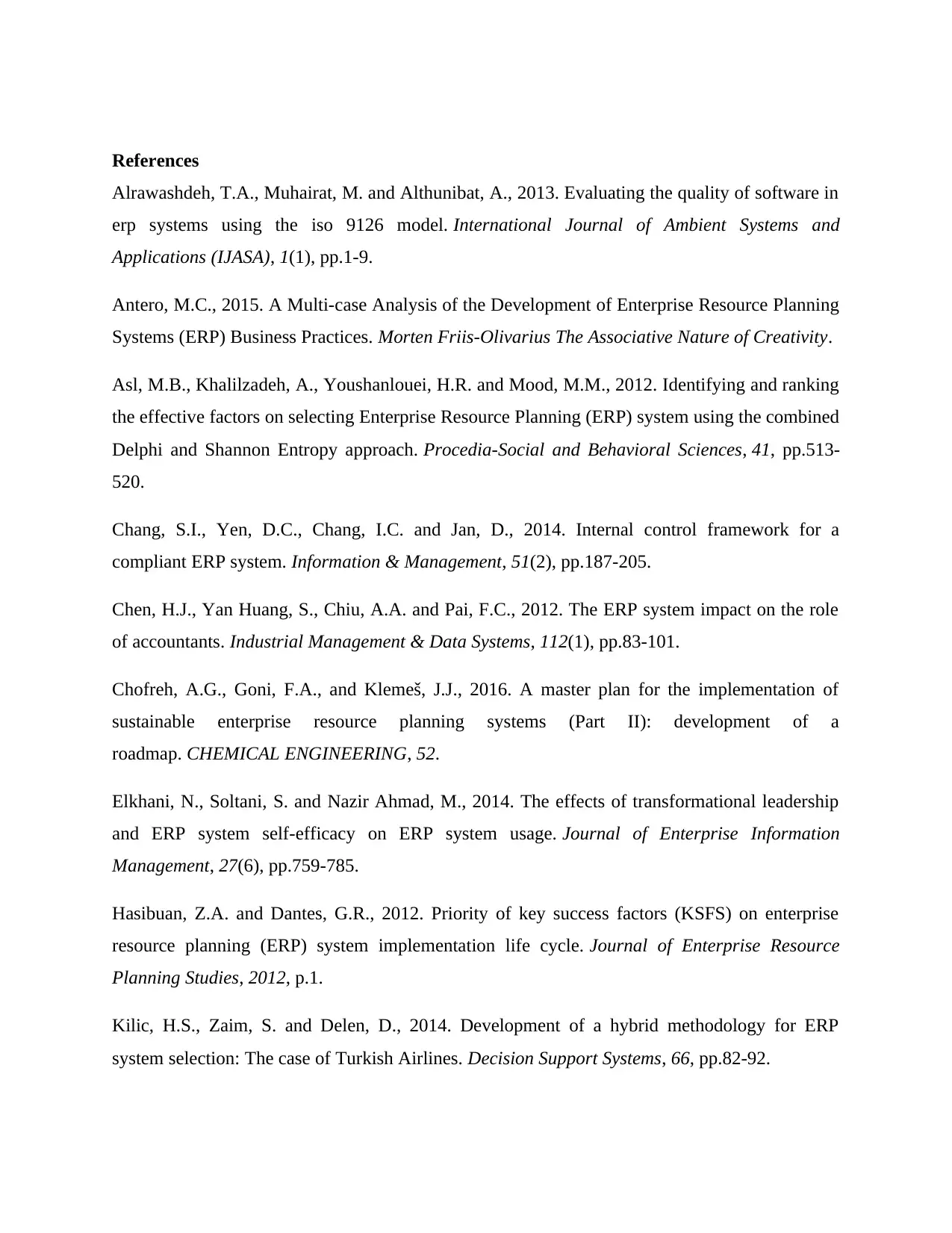
References
Alrawashdeh, T.A., Muhairat, M. and Althunibat, A., 2013. Evaluating the quality of software in
erp systems using the iso 9126 model. International Journal of Ambient Systems and
Applications (IJASA), 1(1), pp.1-9.
Antero, M.C., 2015. A Multi-case Analysis of the Development of Enterprise Resource Planning
Systems (ERP) Business Practices. Morten Friis-Olivarius The Associative Nature of Creativity.
Asl, M.B., Khalilzadeh, A., Youshanlouei, H.R. and Mood, M.M., 2012. Identifying and ranking
the effective factors on selecting Enterprise Resource Planning (ERP) system using the combined
Delphi and Shannon Entropy approach. Procedia-Social and Behavioral Sciences, 41, pp.513-
520.
Chang, S.I., Yen, D.C., Chang, I.C. and Jan, D., 2014. Internal control framework for a
compliant ERP system. Information & Management, 51(2), pp.187-205.
Chen, H.J., Yan Huang, S., Chiu, A.A. and Pai, F.C., 2012. The ERP system impact on the role
of accountants. Industrial Management & Data Systems, 112(1), pp.83-101.
Chofreh, A.G., Goni, F.A., and Klemeš, J.J., 2016. A master plan for the implementation of
sustainable enterprise resource planning systems (Part II): development of a
roadmap. CHEMICAL ENGINEERING, 52.
Elkhani, N., Soltani, S. and Nazir Ahmad, M., 2014. The effects of transformational leadership
and ERP system self-efficacy on ERP system usage. Journal of Enterprise Information
Management, 27(6), pp.759-785.
Hasibuan, Z.A. and Dantes, G.R., 2012. Priority of key success factors (KSFS) on enterprise
resource planning (ERP) system implementation life cycle. Journal of Enterprise Resource
Planning Studies, 2012, p.1.
Kilic, H.S., Zaim, S. and Delen, D., 2014. Development of a hybrid methodology for ERP
system selection: The case of Turkish Airlines. Decision Support Systems, 66, pp.82-92.
Alrawashdeh, T.A., Muhairat, M. and Althunibat, A., 2013. Evaluating the quality of software in
erp systems using the iso 9126 model. International Journal of Ambient Systems and
Applications (IJASA), 1(1), pp.1-9.
Antero, M.C., 2015. A Multi-case Analysis of the Development of Enterprise Resource Planning
Systems (ERP) Business Practices. Morten Friis-Olivarius The Associative Nature of Creativity.
Asl, M.B., Khalilzadeh, A., Youshanlouei, H.R. and Mood, M.M., 2012. Identifying and ranking
the effective factors on selecting Enterprise Resource Planning (ERP) system using the combined
Delphi and Shannon Entropy approach. Procedia-Social and Behavioral Sciences, 41, pp.513-
520.
Chang, S.I., Yen, D.C., Chang, I.C. and Jan, D., 2014. Internal control framework for a
compliant ERP system. Information & Management, 51(2), pp.187-205.
Chen, H.J., Yan Huang, S., Chiu, A.A. and Pai, F.C., 2012. The ERP system impact on the role
of accountants. Industrial Management & Data Systems, 112(1), pp.83-101.
Chofreh, A.G., Goni, F.A., and Klemeš, J.J., 2016. A master plan for the implementation of
sustainable enterprise resource planning systems (Part II): development of a
roadmap. CHEMICAL ENGINEERING, 52.
Elkhani, N., Soltani, S. and Nazir Ahmad, M., 2014. The effects of transformational leadership
and ERP system self-efficacy on ERP system usage. Journal of Enterprise Information
Management, 27(6), pp.759-785.
Hasibuan, Z.A. and Dantes, G.R., 2012. Priority of key success factors (KSFS) on enterprise
resource planning (ERP) system implementation life cycle. Journal of Enterprise Resource
Planning Studies, 2012, p.1.
Kilic, H.S., Zaim, S. and Delen, D., 2014. Development of a hybrid methodology for ERP
system selection: The case of Turkish Airlines. Decision Support Systems, 66, pp.82-92.
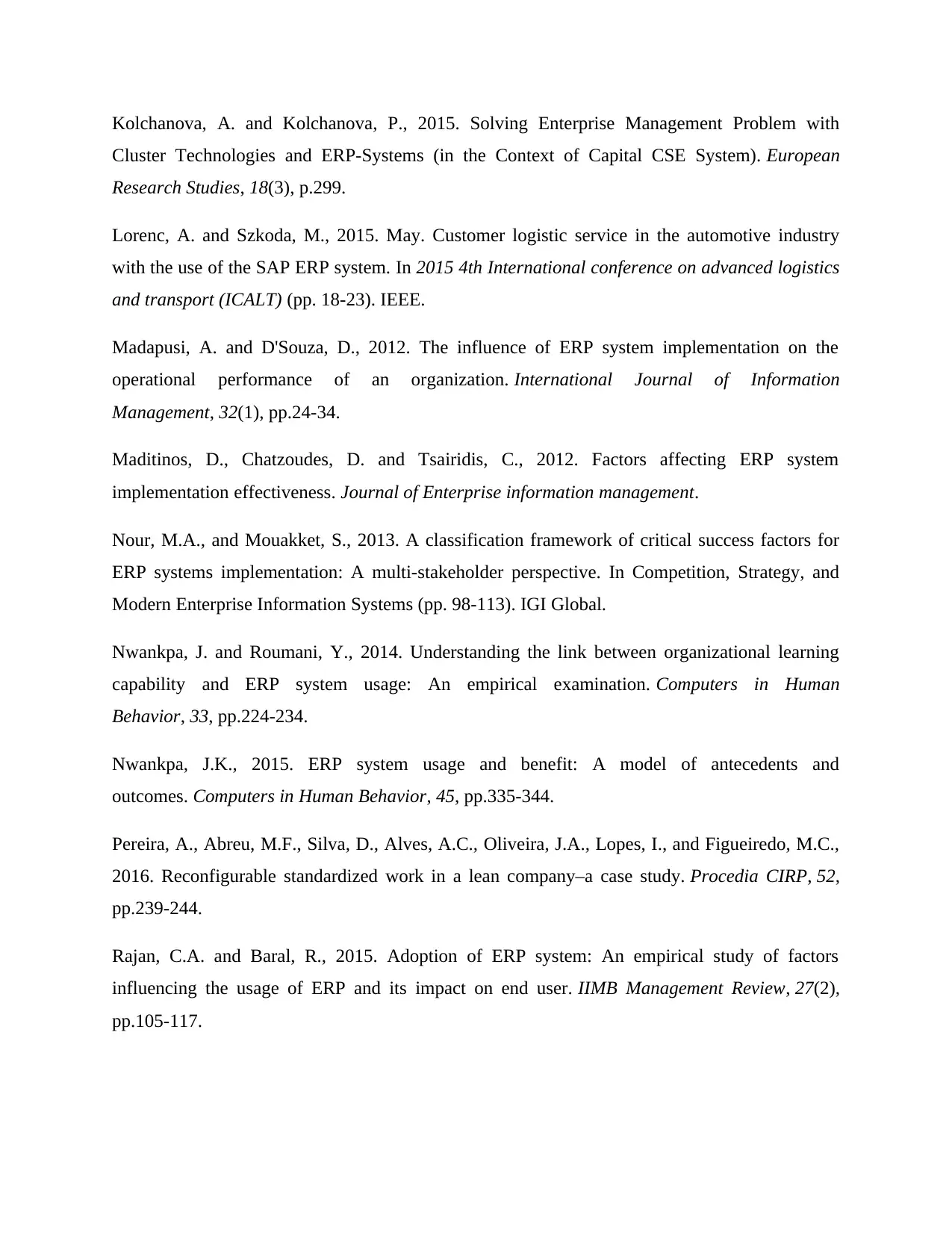
Kolchanova, A. and Kolchanova, P., 2015. Solving Enterprise Management Problem with
Cluster Technologies and ERP-Systems (in the Context of Capital CSE System). European
Research Studies, 18(3), p.299.
Lorenc, A. and Szkoda, M., 2015. May. Customer logistic service in the automotive industry
with the use of the SAP ERP system. In 2015 4th International conference on advanced logistics
and transport (ICALT) (pp. 18-23). IEEE.
Madapusi, A. and D'Souza, D., 2012. The influence of ERP system implementation on the
operational performance of an organization. International Journal of Information
Management, 32(1), pp.24-34.
Maditinos, D., Chatzoudes, D. and Tsairidis, C., 2012. Factors affecting ERP system
implementation effectiveness. Journal of Enterprise information management.
Nour, M.A., and Mouakket, S., 2013. A classification framework of critical success factors for
ERP systems implementation: A multi-stakeholder perspective. In Competition, Strategy, and
Modern Enterprise Information Systems (pp. 98-113). IGI Global.
Nwankpa, J. and Roumani, Y., 2014. Understanding the link between organizational learning
capability and ERP system usage: An empirical examination. Computers in Human
Behavior, 33, pp.224-234.
Nwankpa, J.K., 2015. ERP system usage and benefit: A model of antecedents and
outcomes. Computers in Human Behavior, 45, pp.335-344.
Pereira, A., Abreu, M.F., Silva, D., Alves, A.C., Oliveira, J.A., Lopes, I., and Figueiredo, M.C.,
2016. Reconfigurable standardized work in a lean company–a case study. Procedia CIRP, 52,
pp.239-244.
Rajan, C.A. and Baral, R., 2015. Adoption of ERP system: An empirical study of factors
influencing the usage of ERP and its impact on end user. IIMB Management Review, 27(2),
pp.105-117.
Cluster Technologies and ERP-Systems (in the Context of Capital CSE System). European
Research Studies, 18(3), p.299.
Lorenc, A. and Szkoda, M., 2015. May. Customer logistic service in the automotive industry
with the use of the SAP ERP system. In 2015 4th International conference on advanced logistics
and transport (ICALT) (pp. 18-23). IEEE.
Madapusi, A. and D'Souza, D., 2012. The influence of ERP system implementation on the
operational performance of an organization. International Journal of Information
Management, 32(1), pp.24-34.
Maditinos, D., Chatzoudes, D. and Tsairidis, C., 2012. Factors affecting ERP system
implementation effectiveness. Journal of Enterprise information management.
Nour, M.A., and Mouakket, S., 2013. A classification framework of critical success factors for
ERP systems implementation: A multi-stakeholder perspective. In Competition, Strategy, and
Modern Enterprise Information Systems (pp. 98-113). IGI Global.
Nwankpa, J. and Roumani, Y., 2014. Understanding the link between organizational learning
capability and ERP system usage: An empirical examination. Computers in Human
Behavior, 33, pp.224-234.
Nwankpa, J.K., 2015. ERP system usage and benefit: A model of antecedents and
outcomes. Computers in Human Behavior, 45, pp.335-344.
Pereira, A., Abreu, M.F., Silva, D., Alves, A.C., Oliveira, J.A., Lopes, I., and Figueiredo, M.C.,
2016. Reconfigurable standardized work in a lean company–a case study. Procedia CIRP, 52,
pp.239-244.
Rajan, C.A. and Baral, R., 2015. Adoption of ERP system: An empirical study of factors
influencing the usage of ERP and its impact on end user. IIMB Management Review, 27(2),
pp.105-117.
⊘ This is a preview!⊘
Do you want full access?
Subscribe today to unlock all pages.

Trusted by 1+ million students worldwide
1 out of 12
Related Documents
Your All-in-One AI-Powered Toolkit for Academic Success.
+13062052269
info@desklib.com
Available 24*7 on WhatsApp / Email
![[object Object]](/_next/static/media/star-bottom.7253800d.svg)
Unlock your academic potential
Copyright © 2020–2025 A2Z Services. All Rights Reserved. Developed and managed by ZUCOL.




